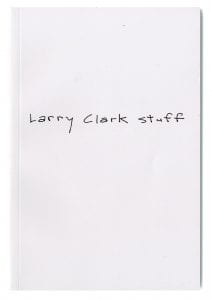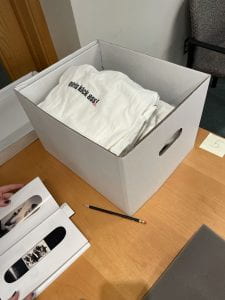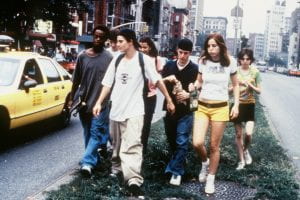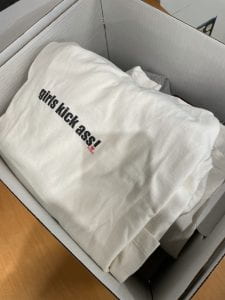This online blog post features materials protected by the Fair Use guidelines of Section 107 of the US Copyright Act. All rights reserved to the copyright owners.
Blog post by Valerie Chu
Larry Clark is known for many things. Film director, photographer, writer, but he is most known for his 1995 film, Kids, which told the story about a group of debauched teenagers skating and fooling around in New York City, all happening in the height of the HIV/AIDS pandemic.

Figure 1 – “Larry Clark stuff” book. Clark, L. (2013). Cornell University Library. Retrieved 2022, from https://newcatalog.library.cornell.edu/catalog/8390990
While exploring the Cornell University Library’s Division of Rare and Manuscript Collections, “Larry Clark stuff” caught my attention. The item itself was a book titled Larry Clark Stuff, which was the title of a Boo-Hooray and United Arrows exhibition (Figure 1). The exhibition was based on the movie “Kids” and featured screen-printed T-shirts, reproductions of Polaroids, and several skateboarding decks.
This box stood out because, unlike the rest of the pieces in the collection that were carefully wrapped in tissue paper or neatly displayed on a hanger, the “Larry Clark stuff” included a few shirts just sitting in a white filing box (Figure 2). I remember the librarians saying that these items have not been formally processed and catalogued yet, but upon further research and thinking, it seems more than appropriate for its home to be in that quaint white box.
Fascinated by the early 1990s skateboard culture, Larry Clark wanted to learn more and understand young people that society deemed as delinquents (Figure 3). At age 50, he started learning how to skate with speed and precision while filming on a camera. He calls New York City a “concrete playground” where the young people were carefree while roaming around the city on skateboards (Clark, 2013). Aside from this freeing lifestyle, he was captivated by the unique silkscreened shirts that the youth would design themselves. From that point onwards, all his works revolved around the themes of skateboarding, drugs, and sex (Engdahl, Jesse, and Jim Honey, 1995).
The T-shirt that caught my eye was a simple white 100% cotton shirt with the phrase “girls kick ass!” across the chest in black and a small heart with the word “Poot” under it (Figure 4). The phrase printed on it intrigued me because it makes a bold statement while simultaneously being a simple T-shirt. The shirt is a size small but fits oversize, and it gives a very carefree and upbeat look. Some might even say it is too simple to be called fashion, but it is an integral style that encapsulates skateboarding culture.
Upon researching what “Poot” was, I learned that Poot is a brand created by Keva Marie Dine as one of the first girl skateboard brands in the world (Huston, 2020). Since this T-shirt was not sold by Larry Clark, I can only assume that this was a brand collaboration because both designers’ work focuses on bold statements about empowerment, freedom, and carefreeness. With that, I also believe that this would’ve been a limited collection because Larry Clark is keen on creating limited quantities of each design.
Expanding more on limited quantities, a big part of skateboarding is wearing whatever you feel comfortable in. Therefore, like other skateboarding brands back then, Clark would only produce limited quantities for each piece to allow for more individualism. Nowadays, skateboarding style has been boxed to a more restricted category called “skate clothes” (Clark, 2013). This shift in skateboarding clothes becoming mainstream is problematic because it is less about skateboarding and more about commercialism.
Larry Clark is quite the epitome of anti-corporate activism, where he sees through the audience and is often satirical about the consumers of his products. In “Larry Clark stuff,” he writes about his experience in creating a skateboard collection with Supreme, and the deal was for him to keep half of the decks created. While collectors paid hundreds to thousands of dollars to acquire these decks, Clark just “gave them to kids in the ghetto” for the skateboards to be used for their intended purposes (Clark, 2013). He now sees skateboarding as “co-opted by companies and commercialism” (Clark, 2013).
A quick search on eBay shows that the resell value of these decks range from $750 to upwards of $3500 (Figure 5). From these high prices, it is sad to see that the essence of skateboarding is being eroded and gentrified through capitalism.
As a piece of 90s history, the box of Larry Clark t-shirts is right where it should be: accessible publicly, and not for commercial purposes or art galleries or collector’s homes. While they were made to be used and worn, they are now preserved in the Division of Rare and Manuscript Collections where they mark a piece of history for students, faculty, and the public to learn and reflect upon. Still, I have an internal sense of struggle between the limitations of the “correct” use of his work. Should they be removed from circulation, preserved, and no longer worn? What would Larry Clark have wanted to happen with his works?
Works Cited:
Clark, Larry. Larry Clark Stuff, Japanese Editon. Edited by Johan Kugelberg , Boo-Hooray, 2013.
Engdahl, Jesse, and Jim Hosney. Film Quarterly, vol. 49, no. 2, University of California Press, 1995, pp. 41–44, https://doi.org/10.2307/1213312 (Links to an external site.).
Giroux, Henry A. “Hollywood, Race, and the Demonization of Youth: The ‘Kids’ Are Not ‘Alright.’” Educational Researcher, vol. 25, no. 2, [American Educational Research Association, Sage Publications, Inc.], 1996, pp. 31–35, https://doi.org/10.2307/1176338 (Links to an external site.).
‘Kids,’ Then and Now – The New York Times. https://www.nytimes.com/2015/07/23/fashion/kids-20th-anniversary-chloe-sevigny-rosario-dawson.html.
Huston, Sarah. “Behind the Brand: Keva Marie Dine of Poot!” Yeah Girl, 25 June 2020, https://yeahgirlmedia.com/behind-the-brand-keva-marie-dine-of-poot/.





